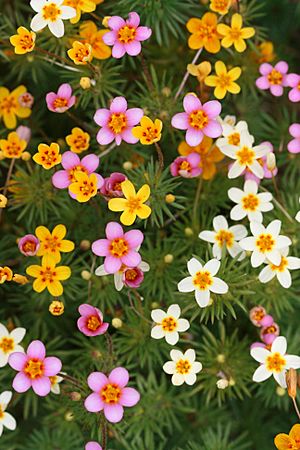Leptosiphon androsaceus facts for kids
Quick facts for kids Leptosiphon androsaceus |
|
|---|---|
 |
|
| Scientific classification | |
| Genus: |
Leptosiphon
|
| Species: |
androsaceus
|
| Synonyms | |
|
Linanthus androsaceus |
|
The Leptosiphon androsaceus, also known as false babystars, is a beautiful flowering plant. It's part of the phlox family. You might also hear it called Linanthus androsaceus, which is another name for it.
Where Do False Babystars Grow?
This special plant is found only in California. This means it's endemic to California, which is a fancy word for saying it naturally lives nowhere else in the world!
You can mostly find it in the San Francisco Bay Area. It also grows in the California Coast Ranges (which are mountain ranges near the coast) in northern and central California. You might spot it in the southern Sierra Nevada mountains and in the Peninsular Ranges and Transverse Ranges of southern California too.
False babystars like to grow in places that are not too high up, usually below 1,200 meters (about 3,900 feet). They thrive in different natural areas like:
- Chaparral: This is a type of shrubland with tough, woody plants.
- Oak woodland: Areas with lots of oak trees.
- Grasslands: Open fields covered in grasses.
There are also other plants that look similar to false babystars. For example, Leptosiphon latisectus grows only in the Outer Northern California Coast Ranges. Another one, Leptosiphon rosaceus, is found along the coastlines of Central California and the Bay Area.
What Do False Babystars Look Like?
The false babystars plant is an annual herb. This means it's a plant that lives for only one year, growing from a seed, flowering, and then making new seeds before it dies.
It has a stem that can be anywhere from 5 to 45 centimeters (about 2 to 18 inches) long. This stem is usually a bit hairy and often stands up straight. The leaves grow opposite each other on the stem. Each leaf is divided into smaller parts, called lobes, which can be up to 3 centimeters long. These lobes can be oval, linear (like a line), or even needle-like in shape.
At the very top of the stem, you'll find a cluster of flowers. This cluster is called an inflorescence. Each flower is usually one to three centimeters wide. They are often pink or lavender, with a yellow or white center, which is called the throat.
This plant looks quite a bit like its cousin, the true babystars (Leptosiphon bicolor).
Can You Grow False Babystars?
Yes, you can! People often grow false babystars as an ornamental plant. This means they grow it because it's pretty and adds beauty to gardens.
It's a great choice for different types of gardens, including:
- Traditional gardens
- Native plant gardens (gardens that use plants originally from the area)
- Drought tolerant gardens (gardens that need very little water)
- Wildlife gardens (gardens designed to attract and help local wildlife)

